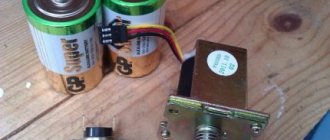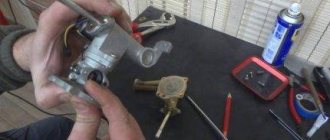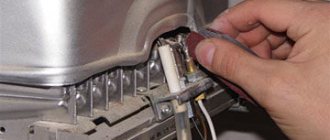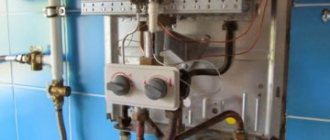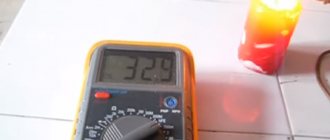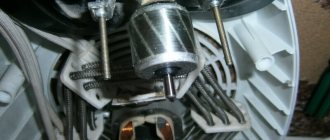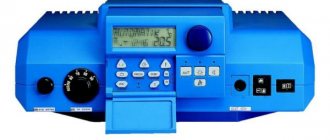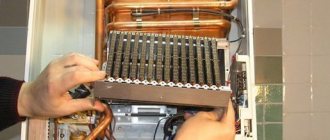Here you will learn:
- The most common causes of breakdowns
- Elimination of traction disorders
- Water pressure problem
- Problems with insufficient gas pressure
- Problems with ignition
- Problem with clogs
- Removing burner blockage
- Gas block and membrane repair
- Mixing cold water in the mixer
- Electronics malfunction
- Finally
Your gas heater won't light and you want to call a technician? We assure you that many malfunctions and breakdowns can be dealt with on your own, without the help of specialists. And the simpler the geyser, the easier it is to repair it. In this review, we will not only talk about the malfunctions, but also give recommendations for eliminating them - after which you will be able to light up your speaker .
The most common causes of breakdowns
Let's start a review of breakdowns using the example of such simple geysers as Oasis or Neva. These are fairly simple devices, so almost any man who knows how to work with tools and has relatively straight hands can handle their repair. Here is a short list of possible faults and causes:
- Lack of traction;
- Insufficient water pressure;
- Insufficient gas pressure;
- Inoperative ignition system;
- Clogged tubes and water supply filter;
- Burner clogged;
- Malfunction of the membrane or gas block;
- Inaccurate mixing of cold water in the mixer;
- Faulty electronics or sensors.
Now we will look at how to eliminate breakdowns and causes of lack of ignition.
Recommendations for preventing breakdowns
To keep your equipment working as long as possible, follow these simple rules:
- Set the temperature correctly so that you do not have to mix cold and hot flow. The higher the set temperature, the faster the scale builds up.
- Install a purification filter that will soften the water and remove impurities from it.
- Clean the internal elements from soot and soot.
- Connect high-power devices to the network through a voltage stabilizer.
We have indicated the reasons for possible problems with the ignition system. Most of them can be eliminated with your own hands. This video will also help you:
Elimination of traction disorders
To test traction, try using an ordinary match. Bring it to the chimney and determine if there is a draft, then the flame will deviate towards the chimney.
If there is no draft, the gas water heater will not light and users will not receive hot water. Many dispensers are equipped with draft sensors, and if they show insufficient draft, ignition will be impossible. Situations are possible when the flame lights up and immediately goes out - this is due to the fact that the combustion products simply have nowhere to go, they remain in the combustion chamber, and the flame goes out due to lack of oxygen. Lack of draft will require an inspection of the flue gas collector and the chimney itself. If there are blockages here, they can interfere with the normal passage of combustion products. The column perceives this as a lack of traction and does not allow the gas to ignite (or the gas goes out immediately after turning on). Unfortunately, you will be able to independently check only the part of the chimney that is visible before entering the wall - further work must be carried out by specialists . If the house is private, you can try to figure out the chimney yourself.
Why doesn't the Astra gas water heater light up?
Why the Astra gas water heater does not light up, we will describe the reasons and ways to eliminate them using the example of model 8910 15 automatic, with electric ignition.
- The gas and water shut-off valves located in front of the device are closed - open the valves.
- There are no or low batteries in the battery compartment; you need to insert or replace the batteries.
- Oxidation of the contacts of the battery pack or batteries - clean the contacts.
- There is no draft in the chimney. This happens when the chimney is clogged. To check, hold a lit candle to the air duct. With good draft, the candle flame should go out; if it does not even deviate, you need to clean the chimney. The draft can be checked using a sheet of newsprint; it should deviate towards the air duct.

Checking traction
- Low water pressure can be due to a number of factors. The first reason is low line pressure; only installing a pump will save you. The filter in front of the water unit of the device or the filter on the faucet mixer may be clogged.

Rinse with a brush with stiff bristles under a strong stream of water; if they are heavily clogged with lime deposits, the filters must be replaced. The next factor may be scale inside the heat exchanger. Unscrew the bolts and remove the heat exchanger. Prepare a solution of citric acid, 100 grams per liter of water, immerse the heat exchanger there, leave for several hours, then rinse thoroughly. For these purposes, you can use special anti-scale agents. - Violation of the integrity of the rubber membrane. You can check this yourself without resorting to the help of specialists. It is enough to remove the casing of the device; there is a membrane in the water block. If it is deformed or torn, it needs to be replaced. Astra speaker membrane The silicone membrane is more durable in use. When installing a new one, you should be careful not to tear it; to do this, you must initially tighten the bolts that are opposite each other. You can do this type of repair yourself.
- The contacts of the electrical circuit are broken - check the connections, if a fault is found, fix it.
- Incorrect water or gas adjustment. If the water line pressure is low and the toggle switch is set to maximum, the device will go out. Make adjustments appropriate to the pressure.
- Stickiness or oxidation of the rod. After disconnecting the microswitch, release the rod; if it is oxidized, clean and lubricate it.

Astra column water assembly rod
- The microswitch is broken. Cannot be repaired, must be replaced.
- The control unit is faulty and cannot be repaired and needs to be replaced.
- The solenoid valve is not working and needs to be replaced.
- No contact between thermocouple and solenoid valve. If, after checking the serviceability of the thermocouple, it turns out that everything is fine with it, it is necessary to clean the contacts.
- The design of the igniter not adjusted to the existing gas pressure is the reason that the unit does not ignite immediately. The electrode is initially mounted so that the spark hits the comb, which is attached to the edge of the gas burner, approximately 12 mm from its edge. If the gas supply is adjusted to low pressure, gas comes out in small quantities and at low speed. A backdraft always forms inside the device and the gas flows under its pressure down the device, not reaching the spark. This is corrected by bending the electrode from the comb to a level where the spark does not fall on the comb, but exactly in the center of the burner. After these measures, the unit ignites quickly, stably and softly.
- The traction control sensor is broken - to check its functionality you need to ring it by connecting two terminals. If it is working, the device will show infinity, otherwise the sensor needs to be replaced.
- Gaps have formed between the joints of the air duct pipe, or between the device pipe and the pipe elbows. Use heat-resistant sealing tape to eliminate gaps.
- If there is no spark during ignition and a cracking sound is heard, the microswitch may be faulty. You can check its performance by short-circuiting it. First you need to remove the unit body, unscrew the bolts, and remove the handles. There is a microswitch at the bottom. If you turn on the hot water valve, the mic button is released by a lever; if this does not happen, it should be pryed off with a screwdriver and lubricated with oil. If after this ignition does not occur, the microswitch must be changed.
- In a situation where there is a spark, there is a click, there is no ignition, the solenoid valve is to blame, it cannot be repaired, it must be replaced.

Solenoid valve - There is no spark, no click, no crackling sound, and at the same time it is verified that the microswitch is working properly, you need to check the electronic ignition unit, and if it is faulty, replace it, since repair is almost impossible.
There are situations when the water heater does not light up immediately, but with some delay. The main reason in this case is contamination of the device. It is necessary to clean the inside of the unit from dust, soot, and soot. Pay special attention to the nozzles and jet.
When using Astra speakers (model 8910RE) with matches ignition, the following ignition problems may occur:
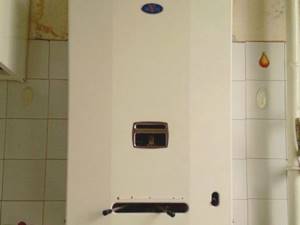
Astra 8910 RE
- The main burner ignites with a noisy bang: firstly, due to low gas pressure, the gas supply needs to be adjusted. Secondly, due to clogging of the plug hole and the igniter nozzle, the situation can be corrected by cleaning the plug hole and the nozzle.
- The main burner and pilot burner do not ignite partly for the reasons listed above, there may be other reasons, for example: contamination of the pilot burner. Over time or if contaminated gas is used, it becomes covered with soot and soot.
If the wick does not burn, this means that the igniter nozzle is clogged with soot; the igniter burner needs to be cleaned. Repairing gas equipment with your own hands is dangerous; this should be done by professionals.
With your own hands, you can only remove the soot located inside the burner jets using thin copper wire, and clean the outside with a brush with metal bristles. After this, you need to check the connections for gas leaks by covering them with soap foam.
Malfunctions not related to the repair of the gas components of the unit can be eliminated independently, but where the problem is related to gas, the intervention of specialists is required.
Water pressure problem

To clean the water filter, disconnect the cold water supply pipe. At the place where it is attached you will see a mesh filter; cleaning it will help restore the pressure.
If your gas water heater does not light up, but everything is fine with the draft, then there may be a problem with the water supply. A small pressure often leads to the ignition not working. You can try to adjust the pressure on the column itself using the appropriate regulator - sometimes this helps (although the regulator is not present in all models). also check the filter installed at the inlet of the column - it could be clogged. If there is no pressure even in a cold water tap, all that remains is to complain to the authorities responsible for water supply - the pressure must correspond to the standards established in the country. If no one is going to do anything, we install a pressure-increasing pump - it will raise the pressure to the required limits and help ignite the gas in your column. Installing a pump is a completely legal operation.
You can also check the pipes passing through the apartment/house; it is quite possible that they are clogged or rusted to such an extent that the clearance has become very small - this has a negative effect on the pressure.
Problems with ignition
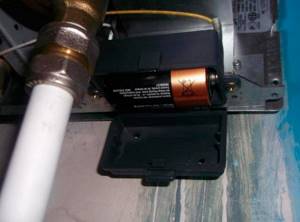
Typically, batteries in geysers are located in the lower right corner, and replacing them does not require much effort.
Situations are often observed when gas is supplied, there is draft, the pressure is normal, but the gas water heater does not ignite. If you have a Neva or Oasis gas water heater installed with electric ignition, listen to see if there is a spark being generated. The presence of a spark is indicated by a characteristic crackling sound heard when the tap is opened. If you hear a crackling sound, but the gas heater does not ignite, try replacing the batteries - this is a very common reason for the lack of ignition (a weak spark makes normal ignition impossible). Owners of speakers with piezoelectric ignition need to make sure that the igniter is working. If it lights up, then the column should light up immediately, without hesitation. If there is no flame, try to light it with the ignition button. If the gas in the igniter does not ignite, then the problem is in the igniter itself (in the nozzle) - it needs to be cleaned. To do this, we disassemble the gas water heater, get to the fuse and clean it with steel wire. Next, we try to light the column again.
When repairing your geyser, be careful and always turn off the gas supply before carrying out any operations.
As for hydrodynamic ignition, it is a combination of a small generator and an electrical circuit that generates a spark and powers some other electronic components. If the generator or circuit fails, the gas water heater will not light. Self-repair here is only possible if you have the appropriate knowledge and experience in electronics repair.
You open a hot water tap, the device does not turn on, there is no spark discharge.
Provided that the gas shut-off valve is open, most likely the solenoid valve has broken down or its connection contacts have become oxidized or disconnected. In the first case, it requires replacement, in the second, clean or connect the contacts.
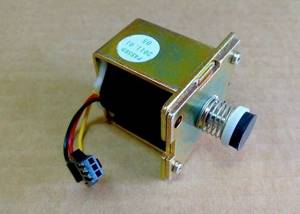
It may also be that the spark does not enter the stream of the air-gas burner. To eliminate this, you need to adjust the distance between the end of the spark plug electrode and the burner nozzle. It should be 5 plus/minus 0.5mm. If you are using liquefied gas, most likely it has run out, replace it with a new cylinder.
Problem with clogs
Filters are often installed at the entrance to the gas water heater, which filter out small solid impurities contained in the water. Salts also settle here, becoming an obstacle to the normal passage of liquid. As a result, the water heater stops lighting up and providing the household with hot water. In this case, you need to turn off the water supply, unscrew the filter and clean it. If the condition of the filter is very severe, then it is easier to replace it.
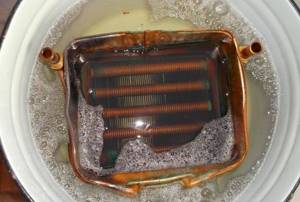
To clean the heat exchanger, soak it in a solution of water and detergent, and pour citric acid into the tubes to the top and leave for half an hour.
Also, during many years of operation of the column, the tubes or heat exchanger may become clogged. In this case, you need to check the permeability of the water unit and make sure that the heat exchanger is permeable. Blockages are removed by washing with special reagents - to purchase them, you should contact your nearest hardware store. After flushing, the functionality of your geyser will be restored.
In order to prevent sediment from clogging the inside of the column, install a decent filter at the entrance to the column, which will remove small impurities and soften hard water.
Removing burner blockage
Unfortunately, the burners in the Neva and Oasis gas water heaters (as in many others) are susceptible to blockages. Most often, this picture is observed in models with piezoelectric ignition. The cause of clogging is the accumulation of soot. It needs to be removed, for which the column is disassembled and the burner itself is removed from it. Any available tools are used for cleaning. After cleaning, the burner should be reinstalled and checked. If necessary, you can immediately clean the heat exchanger - its clogging leads to loss of traction and deterioration of heating.
If your gas heater does not light and you decide to clean it, do it on the balcony or in the open air. Otherwise, soot flying into the air will definitely stain the entire room in which the speaker is installed.
Low pressure in the water supply
When the column refuses to work, the reason may be the water pressure. This “disease” is typical for products: their “sensitive individuals” cannot tolerate pressure changes and fall into a stupor, since the membrane refuses to act on the valve and ignition does not occur.

- In this case, you should confirm your suspicions, so open the tap. If the guess is confirmed, then nothing can be done - you will have to wait at the weather column. Or call the utility company.
- When it is clear that the culprit is not the water pressure, then you should look at the mesh filter of the water unit. It must be washed and checked - if the plaque cannot be washed off, the part can be placed in a solution of citric acid.
- Then it doesn’t hurt to examine the water unit. Some recommend this radical option: remove the column from the wall, turn it off and disconnect the pipes, and then put it “upside down” and pour in the cleaning agent. It must be left in the column for a couple of hours.

If these manipulations do not help, try changing the mixer filter or changing the membrane of the water unit. But to do this, you must first check it for defects.
Gas block and membrane repair
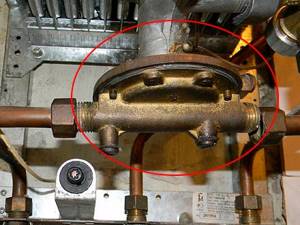
To replace the membrane, remove the column water block. After disassembling it you will get to the membrane.
Sometimes a geyser does not ignite due to damage to the membrane - it reacts to water pressure and controls further ignition. If it is torn, then further operation of the gas water heater will be impossible. Difficulties in repair will be caused by the fact that it is difficult to find a suitable membrane - they are rarely found on sale, and their prices are high. In addition to the membrane, you need to check the entire gas block, since it is full of parts that can fail.
To disassemble and repair the gas block, detailed instructions may be required - they can be found on our website or on the Internet.
Error E1 (ignition error)
If you want to know about which geysers (instantaneous water heaters) you should not choose, about the subtleties and nuances of their installation and connection, as well as hidden information on their proper maintenance for all manufacturers and models, then go here -.
But we also have information on this problem and more, which you will not find anywhere, first of all, because it is asked by specific people who could not get more support and advice anywhere (which they themselves tell us). And secondly, their problems are so complex that sometimes our expert Alexander Kholodov takes 10 days or more to deal with people.
And now EVERY question from the user and the answer to it, in order to avoid financial costs as a result of improper operation or repair of the flow-through heater. And here it doesn’t matter which manufacturer’s device is involved in the issue. All that matters is the unique situation as a result of which the issue arose, because as one good saying goes: “forewarned is forearmed.”
One can only envy the owner of a gas water heater: he always has hot water.
Modern water heaters are very convenient, because just open the water tap and the device will turn on automatically, and even adjust the temperature as needed.
But sometimes events develop according to a less favorable scenario: the user, with increasing irritation, tries an icy stream of water with his hand, but the long-awaited sound that the burner flares up cannot be heard.
You will have to postpone hygiene procedures and try to understand why the gas water heater does not light up. This article will help you find and eliminate the causes of problems.
A gas instantaneous water heater will operate successfully only if all its subsystems are in proper condition. Here is their list:
- Water circuit:
This is simply a specially configured pipe (heat exchanger) through which water flows. The main condition for this component is sufficient bandwidth. - Gas burner:
will only work if the valve on the gas supply line is open. - Ignition system:
this is a device that ignites the gas coming from the burner at the right moment. If it malfunctions, the column, of course, will not be able to turn on. Some ignition systems have a pilot burner (pilot). - Smoke removal system:
there should be no insurmountable obstacles on the path of combustion products from the burner itself to the atmosphere. The main part of this system is not a component of the column - it is a vertical or horizontal chimney facing the street. - Automation:
this system includes a whole set of devices and sensors, and they all control the operation of the gas valve.
Automation can be mechanical...:
- a membrane installed in the water circuit and connected to the gas valve. Reacts to changes in water pressure;
- bimetallic plate. If the pilot burner suddenly goes out, the plate will cool down and cut off the gas supply.
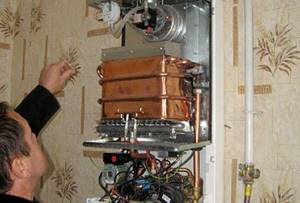
... and electronic:
- draft sensor: blocks the gas supply if there is a danger of combustion products entering the room;
- flame sensor installed in columns without a pilot burner: triggered when the main burner goes out;
- overheat sensor.
Disturbances in the operation of any of the listed systems manifest themselves as follows:
- the burner does not light at all;
- the flame flares up, but immediately goes out (the gas water heater lights up and goes out);
- The igniter cannot be lit.
Let us consider in more detail the reasons causing such phenomena.
Gas equipment is a high-risk device, therefore, according to the regulations, it is carried out by the gas service. See our website for basic installation requirements.
Let's consider the operating principle of a pressure switch for a hydraulic accumulator. We will also look at the adjustment procedure.
Power, ignition system, security system are important criteria that need to be taken into account when choosing a gas water heater. This topic provides a detailed overview of the choice of gas equipment.
Mixing cold water in the mixer
Many people, instead of adjusting the degree of heating on the gas water heater itself, mercilessly torment the mixer. If you open the cold water too much, the lit column will simply go out. If at that moment it was not burning, then it will certainly not catch fire. Make it a rule to turn on the hot water supply first, and only then the cold water supply. It’s best to adjust the degree of heating using the appropriate controls.
You also need to remember that intensive mixing of cold water is not welcomed by the developers of geysers - this can lead to their damage.
Electronics malfunction
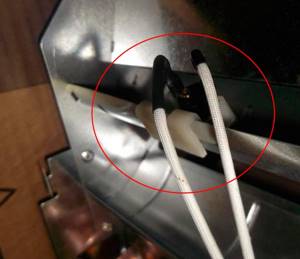
The draft sensor in geysers is usually located on top. It is attached to the chimney.
Modern geysers have many electronic units and sensors on board - only the simplest models do not have them. Sensors monitor draft and the presence of flame (ionization control), monitor the water temperature and automatically regulate the degree of its heating. If one of the sensors fails, the gas water heater will malfunction. The most typical malfunction is a breakdown of the draft sensor in the exhaust gas manifold. As a result, the electronics will not give the go-ahead for ignition. Failures also occur in electronic modules installed in many geysers. Repairing them is complicated by the fact that this requires special knowledge in the field of electronics and circuit design. If you are sure that electronic components are faulty, but do not have the necessary knowledge, feel free to call a specialist.
Water heater operating algorithm
If you have little understanding of the structure and operating principle of a modern geyser, we recommend that you familiarize yourself with this section, otherwise you will not be able to repair the device. The design of an atmospheric heater with an open combustion chamber is shown in the diagram below.
Note. The photo shows an old type column with manual ignition of the burner from a piezoelectric element. Updated versions of the devices (including the Russian brand “Neva”) ignite automatically; the power source is batteries or a 220-volt home power supply.

Newer versions of the columns are powered by batteries or the house electrical network. A turbocharged column is designed in a similar way, only the combustion chamber is completely closed, and a fan supplies air to the burner. The algorithm for starting the unit and heating water for DHW needs looks like this:
- After opening the mixer tap, a flow occurs through the water unit and the column heat exchanger.
- A membrane installed inside the frog body pushes the rod forward due to water pressure. The latter compresses the spring of the mechanical valve in the gas block, opening the passage of fuel to the burner.
- At the same time, the rod releases the microswitch button, closing the solenoid valve circuit. It is triggered and releases gas into the supply tube, where there is an already open spring valve.
- At this moment, the pulse device delivers a high-voltage discharge to the electrodes installed near the burner. A spark ignites and the water begins to heat up.
- Three sensors are connected in series to the solenoid valve circuit - thrust, overheating and flame (ionization). When the latter detects the presence of fire, sparking stops.
Reference. In older water heaters, instead of two electrodes igniting the main burner, one contact and a constantly burning pilot light are used. The presence of a flame is monitored by a thermocouple.
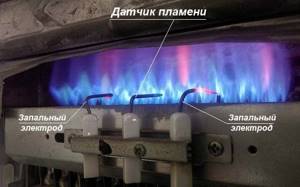
Now let's look at the most important point necessary for successful repairs. Under what conditions does the column automatically turn off (the main burner goes out):
- when the flow and pressure of water disappear, the “frog” releases the pusher, the microswitch opens, and the power supply to the solenoid valve is interrupted;
- if the ionization electrode does not “see” the flame and does not give the corresponding signal, the magnetic valve closes the gas;
- the draft in the chimney disappears, the sensor breaks the circuit and the electromagnet turns off, cutting off the fuel supply;
- The overheat sensor installed on the heat exchanger affects the gas block in a similar way.
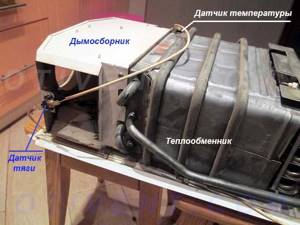
Having understood the principle of operation, you can proceed to diagnosing column malfunctions and making repairs yourself.


